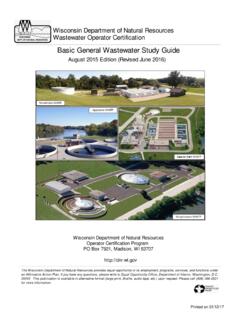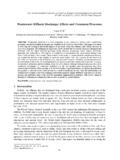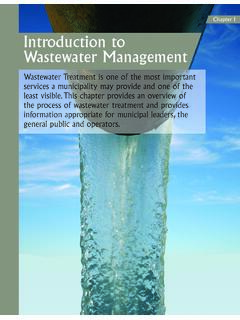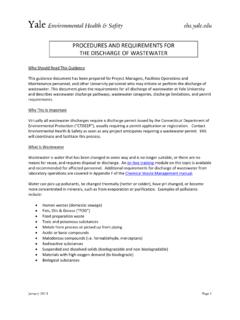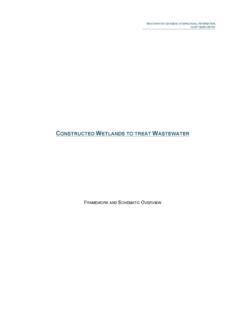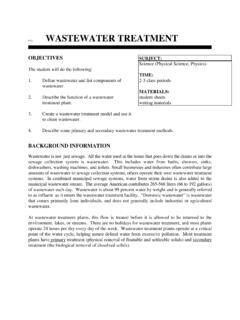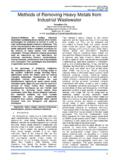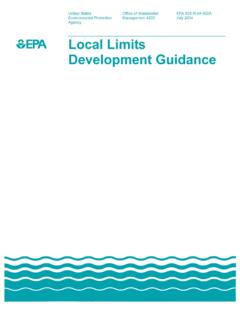Transcription of Wastewater Story - NCERT
1 SCIENCE220 Wastewater Story18 All of us use water in our homes andmake it ! Are you surprised?Rich in lather, mixed with oil, black brown water that goes down the drainsfrom sinks, showers, toilets, laundriesis dirty. It is called Wastewater . Thisused water should not be wasted. Wemust clean it up by removing you ever thought where thewastewater goes and what happens to it? , OUR LIFELINEC lean water is a basic need of humanbeing. Let us make a mindmap of themany uses of clean (We have given one example of theuse of clean water. You can add manymore.)Clean water that is fitfor use is unfortunatelynot available to all.
2 It hasbeen reported that morethan one billion of peoplehave no access to safedrinking water. This accounts for a largenumber of water-related diseases andeven deaths. People even children walkfor several kilometres to collect cleanwater, as you read in Chapter 16. Is itnot a serious matter for human dignity?You have studied in Chapter 16about the increasing scarcity of fresh-water due to population growth,pollution, industrial development,mismanagement and other the urgency of the situationon the World Water Day, on 22 March2005, the General Assembly of theUnited Nations proclaimed the period2005 2015 as the International Decadefor action on Water for life.
3 All effortsmade during this decade aim to reduceby half the number of people who donot have access to safe drinking has been perceptible progressin the direction of the aim but still thereis a lot to of water is a process ofremoving pollutants before it enters awater body or is reused. This process ofwastewater treatment is commonlyClean waterput to useDrinking2022-23 Wastewater STORY221known as Sewage Treatment . It takesplace in several WHAT IS SEWAGE?Sewage is Wastewater released by homes,industries, hospitals, offices and otherusers. It also includes rainwater that hasrun down the street during a storm orheavy rain.
4 The water that washes offroads and rooftops carries harmfulsubstances with it. Sewage is a liquidwaste. Most of it is water, which hasdissolved and suspended an open drain near your home,school or on the roadside and inspectwater flowing through colour, odour and any otherobservation. Discuss with your friendsand your teacher and fill up thefollowing Table know that sewage is a complexmixture containing suspended solids,organic and inorganic impurities,nutrients, saprophytes and diseasecausing bacteria and other include the impurities Human faeces,animal waste,oil, urea (urine),pesticides,herbicides, fruitand vegetablewaste, impurities Nitrates,Phosphates, Phosphorusand Such as vibriocholera whichcauses choleraand salmonellaparatyphi whichcauses microbes Such WATER FRESHENS UP ANEVENTFUL JOURNEYIn a home or a public building generallyone set of pipes brings clean water andanother set of pipes takes awaywastewater.
5 Imagine that we could seethrough the ground. We would see anetwork of big and small pipes, calledTable Contaminant surveyS. No. Type of sewagePoint of originContaminantsAny wasteIndustrialand commercialorganisations2022-23 SCIENCE222sewers, forming the sewerage. It is likea transport system that carries sewagefrom the point of being produced to thepoint of disposal, treatment are located at every 50 mto 60 m in the sewerage, at the junctionof two or more sewers and at pointswhere there is a change in the sewage route in your home/school/building. Do the following: Make a line diagram of the sewageroute. Walk down the street or survey thecampus to find the number ofmanholes.
6 If possible, observe open drain andrecord which living organisms arefound in and around case you do not have a seweragesystem in your locality, find out howsewage is being disposed of polluted waterPerform the following activity. It will helpyou understand the processes that takeplace at the Wastewater treatment yourself into groups to performthe activity. Record observations at eachstage: Fill a large glass jar 3/4 full of some dirty organic matter suchas grass pieces or orange peels, asmall amount of detergent, and a fewdrops of an ink or any colour. Cap the jar, shake it well and let themixture stand in the sun for twodays.
7 After two days, shake the mixtureand pour a small sample into testtube. Label this test tube Beforetreatment; Sample 1 . How does itsmell? Use an aerator from an aquarium tobubble air through the sample in theglass jar. Allow several hours foraeration; leave the aerator attachedovernight. If you do not have anaerator, use a mechanical stirrer ora mixer. You may have to stir itseveral times. The next day when aeration iscomplete, pour another sample intoa second test tube. Label it as Afteraeration; Sample 2 . Fold a piece of filter paper to form acone. Wet the paper with tap waterand then insert the cone in a the funnel on a support(as you have learnt in Class VI).
8 Place layers of sand, fine gravel andfinally medium gravel in the funnel(Fig. ). (An actual filtration plantdoes not use filter paper, but the sandfilter is several metres deep). Pour the remaining aerated liquidthrough the filter into the not allow the liquid to spill overthe filter. If the filtered liquid is notclear, filter it a few times till you getclear water. Pour a sample of the filtered waterinto a third test tube labelled Filtered; Sample 3 .2022-23 Wastewater STORY223 Pour another sample of the filteredwater into a fourth test tube. Add asmall piece of a chlorine tablet. Mixwell until the water is clear. Label thetest tube Chlorinated; Sample 4.
9 Observe carefully the samples in allthe test tubes. Do not taste! Justsmell them!Now answer the following questions:(a)What changes did you observe in theappearance of the liquid afteraeration?(b)Did aeration change the odour?(c)What was removed by the sand filter?(d)Did chlorine remove the colour?(e)Did chlorine have an odour? Was itworse than that of the Wastewater ? Wastewater TREATMENT PLANT(WWTP)Treatment of Wastewater involvesphysical, chemical, and biologicalprocesses, which remove physical,chemical and biological matter thatcontaminates the is passed through barscreens. Large objects like rags,sticks, cans, plastic packets, napkinsare removed (Fig.)
10 Fig. Filtration processFig. Bar screenFig. Grit and sand removal then goes to a grit and sandremoval tank. The speed of theincoming Wastewater is decreased toallow sand, grit and pebbles to settledown (Fig. ). water is then allowed to settle ina large tank which is sloped towardsthe middle. Solids like faeces settleat the bottom and are removed with2022-23 SCIENCE224 After several hours, the suspendedmicrobes settle at the bottom of the tankas activated sludge. The water is thenremoved from the activated sludge is about 97%water. The water is removed by sanddrying beds or machines. Dried sludgeis used as manure, returning organicmatter and nutrients to the treated water has a very low levelof organic material and suspendedmatter.











